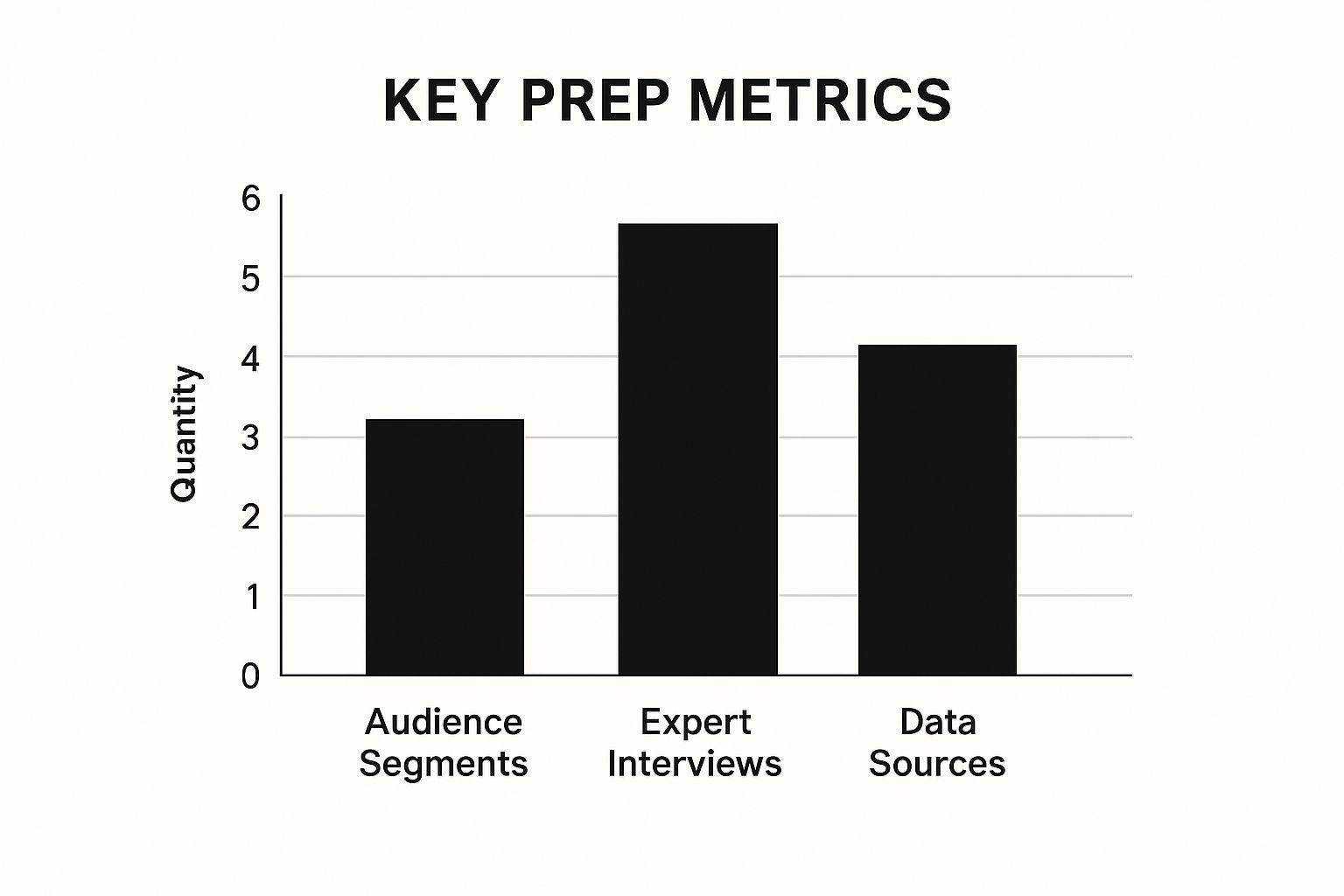A white paper isn't just a long-form document; it’s a power play in B2B marketing. It’s how you build authority and trust by offering deep, data-driven solutions to your audience’s most complex problems, guiding them through high-stakes decisions.
Why White Papers Still Dominate in B2B Marketing

In a sea of snackable content and 60-second videos, the white paper stands alone. It’s not just another blog post; it’s a declaration of expertise. While a blog’s job is often to attract and entertain, a white paper must educate and persuade on a much deeper level. It’s your way of showing potential clients you understand their challenges inside and out.
This is exactly why they remain a cornerstone of any serious B2B marketing strategy. They address the kind of nuanced, high-stakes issues that simply can't be unpacked in a quick article. Think of it as the difference between a casual chat and a detailed consultation with a seasoned expert.
The Power of Education over Promotion
The best white papers don’t sell; they teach. They avoid shouting about product features and instead offer genuine, expert guidance. By focusing entirely on solving a real problem for your reader, you build a level of trust that no direct sales pitch can ever hope to achieve.
Imagine a SaaS company selling a sophisticated cybersecurity platform. A weak paper would be titled "Why Our Software is #1." A powerful one would be "The CIO’s Guide to Mitigating AI-Driven Phishing Threats." See the difference? The second one immediately positions them as a trusted authority, making their solution the logical next step when the time comes to buy.
A white paper's true purpose is to shift a reader's perspective with credible, evidence-based arguments. When you get this right, you don’t just generate leads—you create educated buyers who are already sold on your expertise before a salesperson ever dials their number.
Driving High-Value Leads and Decisions
White papers are absolute workhorses for lead generation, particularly for companies with longer, more considered sales cycles. Because of their depth, they naturally attract a more qualified audience—the people who are actively researching a major business challenge. Placing this high-value content behind a simple form is a proven way to capture leads who are already well into their buying journey.
And the numbers don't lie. White papers are incredibly effective at influencing purchasing decisions, pulling in an average conversion rate of 4.6%—nearly double that of most other content formats. In the tech industry, a staggering 91% of buyers say white papers are a key resource in their decision-making process.
This is why a well-crafted white paper is one of the most reliable tools for filling your sales pipeline. You're not just collecting contacts; you're attracting prospects who are genuinely invested in finding a solution. To see how this fits into a larger framework, it's worth exploring these 10 proven B2B lead generation strategies. It's how you turn a simple marketing asset into a powerful engine for business growth.
Comparing White Papers to Other Content Formats
To really appreciate the unique role of a white paper, it helps to see how it stacks up against other common content types like blog posts and case studies. Each format has its strengths, but they serve different purposes in the marketing funnel.
| Attribute | White Paper | Blog Post | Case Study |
|---|---|---|---|
| Primary Goal | Educate & persuade on a complex topic | Attract & engage a broad audience | Prove value through real-world results |
| Depth | In-depth, exhaustive research | Broad overview, surface-level | Specific, focused on one customer story |
| Tone | Authoritative, formal, data-driven | Conversational, accessible | Story-driven, testimonial-focused |
| Target Audience | Decision-makers in late-stage research | Top-of-funnel, general interest | Mid-to-late stage, evaluating options |
| Lead Quality | High-intent, highly qualified | Varies widely, often low-intent | High-intent, solution-aware |
This table shows that while a blog post might bring someone to your website and a case study can seal the deal, the white paper is what builds the foundational trust and authority needed to close complex B2B sales.
Laying the Groundwork Before You Write a Word
Most people think writing a white paper starts with a blank document. That’s a mistake. The best, most influential white papers are built on a solid foundation of research and strategy long before a single word is written. This prep work is what separates a PDF that gets ignored from an asset that builds real authority.
Think of this stage as building a case. You’re not just exploring a topic; you’re developing a specific, compelling argument that solves a real problem for a very specific person.
Define Your Ideal Reader with Precision
Let’s get one thing straight: "CIOs" is not an audience. It’s a job title. If you want your white paper to land with impact, you need to get much, much more specific.
Try something like this instead: "CIOs at mid-sized healthcare organizations who are currently evaluating new cloud security protocols to meet stricter HIPAA compliance." Now that's an audience.
Getting this granular is the key. It dictates everything—the language you use, the pain points you highlight, and the solutions you present. To really nail this, you need to dig deep. Our complete guide on how to research your target audience shows you how to move past demographics and build personas that truly inform your content.
Build Your Argument with Unique Insights
A white paper isn’t a book report. Its value comes from offering a fresh perspective, original data, or expert analysis that your reader simply can't find with a quick Google search. You’re not just curating facts; you’re creating new knowledge.
This is where the real research begins. Don't just hunt for stats that back up what you already think. Instead, dive into the topic to uncover a powerful central argument that will become the backbone of your entire paper.
I've found the most compelling insights come from a mix of three research pillars:
- Tap Your Internal Experts: Your company is full of smart people. Schedule time with your product managers, lead engineers, or senior strategists. These conversations are goldmines for unique stories and perspectives that only your organization can offer.
- Generate Original Data: Nothing grabs attention like fresh data. Can you run a quick survey? Analyze your own user data? Even a small, focused poll of 100 industry professionals can produce a unique statistic that makes your entire white paper stand out.
- Lean on Credible Third-Party Sources: Back up your original findings with data from respected academic journals, industry reports, and government studies. Always, always cite your sources. It’s a simple way to build trust.
The best white papers pull from all these areas. It’s not about relying on one source but blending them to create a rich, multi-layered argument.

As you can see, a solid prep phase involves talking to people, analyzing different data sets, and understanding your audience from multiple angles.
Formulate a Single, Powerful Thesis
All this research should lead you to one thing: a single, defensible argument. This isn’t your topic. It’s your take. It’s the one sentence you want your reader to remember and repeat.
A weak thesis sounds like this: "Cloud security is important for healthcare." It’s true, but it’s obvious and uninspired.
A strong thesis is specific and takes a stand: "For mid-sized healthcare providers, a hybrid-cloud security model offers a superior balance of compliance, cost-efficiency, and data accessibility compared to fully on-premise or public cloud solutions." See the difference?
This single sentence is your North Star. Every section, every data point, and every example in your white paper must work to support this central argument. If a piece of information doesn't reinforce your thesis, cut it.
This disciplined approach is what turns a generic report into a persuasive, memorable piece of thought leadership. It ensures every word has a job to do: guiding your reader from their problem to your unique solution.
Structuring Your White Paper for Maximum Impact

The difference between a white paper that drives leads and one that collects digital dust almost always comes down to structure. A solid framework does more than just organize your thoughts; it takes your reader on a carefully planned journey, moving them from a known problem to a new, better perspective.
Without that clear path, even the most groundbreaking research gets lost in the noise.
Think of it like building a house. You wouldn't just start throwing up walls without a blueprint. Your white paper's structure is that blueprint. It ensures every section supports the main argument and guides the reader toward an inevitable, powerful conclusion. While there’s no single, rigid template, a couple of proven frameworks consistently get the job done.
Choosing Your Narrative Framework
The right structure for your white paper depends entirely on your goal and your audience. Are you untangling a complex, industry-wide problem? Or are you laying out a list of actionable best practices? Your choice here sets the entire tone.
Let's look at two of the most effective models I've seen in action:
- The Problem/Solution Model: This is the classic for a reason—it works. It's perfect when you're tackling a big, thorny challenge your audience is wrestling with. You start by diving deep into their pain point, using hard data to prove it’s a real issue. Then, you methodically introduce your unique solution, connecting the dots to show exactly how it solves the problem you just detailed.
- The Numbered List Model: This format is a winner when you need to present clear steps, tips, or strategies. You've seen the titles: "5 Ways to Secure Your Hybrid Cloud Environment" or "7 Cost-Saving Strategies for SaaS Subscription Management." This structure is incredibly scannable and promises tangible takeaways, which is exactly what a busy executive looking for quick insights wants.
For example, a cybersecurity firm might use the Problem/Solution model to expose a new ransomware threat. On the other hand, a financial consulting firm could use a Numbered List to outline retirement planning mistakes to avoid. It’s all about matching the framework to the story you need to tell.
The Anatomy of a Powerful Outline
Once you've settled on a framework, it's time to build the skeleton: your outline. This is where you map out every section, ensuring each one logically builds on the last. A detailed outline is your best weapon against writer's block and the key to a coherent, persuasive final draft.
A great outline doesn't just list topics; it defines the purpose of each section. It forces you to think about how each piece of the puzzle fits together to build a compelling and irrefutable argument for the reader.
Before you start writing, every white paper outline needs a few non-negotiable components. We've put together a quick breakdown of what those are and why they matter.
Essential Components of a White Paper Outline
This table breaks down the key sections you'll need to create a comprehensive and persuasive white paper that guides your reader from start to finish.
| Section | Purpose | Key Elements |
|---|---|---|
| Title Page | Make a professional first impression and state the topic clearly. | Compelling title, your company logo, author name, and publication date. |
| Executive Summary | Hook busy decision-makers and summarize the entire argument. | Briefly state the problem, the main findings, and the core conclusion in under 200 words. |
| Introduction | Set the stage and articulate the specific problem you will solve. | A strong opening that grabs attention, defines the scope, and outlines what the reader will learn. |
| Main Body | Build your case with data, examples, and expert analysis. | Several logically sequenced sections that support your thesis. This is the heart of your research. |
| Conclusion | Summarize your findings and provide a clear path forward. | Reiterate your main argument and key takeaways. Offer a forward-looking statement. |
| About Us | Briefly introduce your company and its expertise. | A short paragraph positioning your brand as a credible authority on the topic. |
| Call-to-Action (CTA) | Guide the reader on their next step. | Suggest a demo, a consultation, or another relevant piece of content. Make it a soft sell. |
Mapping these elements out first saves a massive amount of time and ensures you don't miss any critical pieces of your argument.
Crafting a Hooking Executive Summary
If a busy executive reads only one part of your white paper, I guarantee it will be the executive summary. This short, powerful section sits right after the title page and must distill your entire 3,000-word argument into a compelling, bite-sized synopsis.
Its job is simple but absolutely critical: convince the reader that the rest of the document is worth their precious time. It has to establish the problem's urgency and hint at a valuable solution—fast.
Think of it as the trailer for your movie. It needs to show off the best parts without giving away the ending. Your goal is to make it impossible for them not to keep reading.
Writing to Inform, Not Just to Impress
Alright, you’ve done the heavy lifting. Your research is solid and your outline is your roadmap. Now it's time to turn that framework into a compelling story. This is where the magic happens, transforming facts and figures into a narrative that truly connects with your reader.
The goal here isn't to sound like an academic paper or a stuffy corporate report. You want to strike that perfect balance: authoritative but not arrogant, clear but not condescending. Think of yourself as a trusted advisor, the person your reader turns to for straight-talking, expert guidance.
Making the Complicated Clear
One of the biggest hurdles in writing a great white paper is taking a complex, often technical, topic and making it accessible. It's easy to just dump data on the page, but that doesn't help anyone. Your real job is to translate that information into something meaningful for your reader's world.
How do you do that? Analogies and real-world examples are your best friends here.
Are you explaining a sophisticated data encryption process? You could compare it to an unbreakable secret code that only the right people can decipher. Trying to illustrate the value of a new software integration? Picture it as building a superhighway between two busy cities that were once completely cut off from each other.
These little storytelling tricks do more than just simplify; they make abstract ideas stick. They show you don't just know your stuff—you know how to make it matter to your audience. That’s a subtle but incredibly effective way to build trust.
A white paper should feel less like a textbook and more like a guided tour. Your job as the writer is to be the expert guide who not only points out the important landmarks (your data) but also tells the compelling stories behind them (your analysis and examples).
Nailing the Introduction and Conclusion
Think of your intro and conclusion as the bookends of your entire argument. They’re the first and last things someone reads, so they need to pack a punch.
Your introduction has to make a promise. Right out of the gate, the reader needs to understand:
- The exact problem you're about to solve.
- Why this matters to them, right now.
- The specific insights they'll walk away with.
Don’t bury the lead. Hit them with a startling statistic or a relatable pain point immediately. Hook them in and set the stage for everything that follows.
Then there’s the conclusion. Its job is more than just a quick summary. A strong conclusion ties all your main points together into one powerful, final thought. It has to answer the "So what?" question and give the reader a clear path forward, leading them naturally to your call-to-action without being pushy.
Using AI as a Tool, Not a Crutch
Let's be real—the writing process has changed. AI writing assistants are here, and they can be a massive help in getting that first draft down. In fact, using AI smartly can cut your writing time by 35% to 45%. That's more time you can spend on strategy, research, and refining your core message.
This efficiency also has a real impact on the bottom line. A white paper that might have cost $5,000 to produce from scratch could be done for closer to $3,000 when you use AI to handle some of the initial legwork. If you're curious about how this is shaking up the industry, the blog over at That White Paper Guy has some great insights. It's all about working smarter, not harder, to produce top-tier content faster.
Designing and Promoting Your White Paper for Maximum Impact

You’ve wrestled with the research and hammered out a powerful, data-driven argument. But let’s be honest: even the most game-changing content will collect dust if it looks like a wall of text or never reaches the right people. This is where the real work begins. The post-writing phase—design and promotion—is what elevates your white paper from a simple document into a strategic asset for your business.
Think about it this way: 71% of B2B buyers rely on white papers when making purchasing decisions. If your document is poorly designed or impossible to find, you’re essentially invisible to a huge chunk of your target market. This final push is what separates a file that gets downloaded and forgotten from a resource that actually generates leads and cements your authority.
Turn Your Draft into a Design Masterpiece
Design isn't just about making things look pretty. It’s about clarity, credibility, and making complex information digestible. A professional, clean design instantly signals that the content inside is just as thoughtful and trustworthy. On the flip side, amateurish design can sink your credibility before a single word is read.
Here are a few core principles I’ve learned make all the difference:
- Embrace Whitespace: Cluttered pages are overwhelming. Generous whitespace—the blank areas around your text and images—gives your content room to breathe. This simple trick makes the document feel more approachable and far easier to read.
- Use Brand-Aligned Visuals: Your white paper should feel like a natural part of your brand. Weave in your company’s logo, color palette, and fonts. This consistency reinforces brand recognition and pulls everything together into a cohesive, professional package.
- Prioritize Clean Typography: Stick to a clean, legible font for the body text. Pair it with a complementary font for headings to create a clear visual hierarchy. Good typography does the heavy lifting of guiding the reader’s eye, making the entire document scannable at a glance.
The real goal of design is to remove friction. Every element, from a chart's color to the spacing between paragraphs, should make it easier for the reader to absorb your core message, not harder.
Build a Multi-Channel Promotion Engine
Your promotion plan needs to be just as strategic as your writing process. Simply hitting "publish" and crossing your fingers is not a strategy. To get your white paper in front of the right people, you need a multi-channel approach.
It all starts with a dedicated, high-converting landing page. This page has one job and one job only: convince visitors that your white paper is valuable enough to trade their contact information for. It needs a magnetic headline, a few bullet points that tease the key takeaways, and a simple, frictionless form.
Nurture and Distribute Your Content
Once someone downloads your white paper, the journey has just begun. This is your chance to build a relationship and guide them toward the next step.
1. Craft an Email Nurture Sequence: Don't stop at the "thank you" email. Set up a short, automated series of 3-4 emails that expands on the white paper’s topics. You could share a related blog post, invite them to a webinar on the subject, or offer a relevant case study. The idea is to keep providing value and stay top-of-mind.
2. Leverage Targeted Social Outreach: For B2B, LinkedIn is a goldmine. Pull out key statistics or compelling quotes from the paper and share them as standalone posts, always linking back to your landing page. You can also run targeted ads to reach specific job titles, industries, or companies that fit your ideal customer profile.
3. Equip Your Sales Team: Your white paper is a secret weapon for your sales team. It can be an icebreaker for a cold outreach, a follow-up resource after a demo, or a perfect way to educate a prospect on a complex problem your product solves. Give them key talking points and show them how to use the content to open doors and move conversations forward.
By weaving your white paper into every stage of your marketing and sales funnel, you truly maximize its reach and ensure it delivers a measurable return on all that hard work.
Measuring the ROI of Your White Paper
You’ve poured a ton of time, expertise, and resources into creating a killer white paper. Now comes the moment of truth: proving it was all worth it. Measuring your return on investment (ROI) isn’t just about making your boss happy or justifying the budget. It’s about figuring out what’s actually working so you can get smarter with your content strategy.
It's tempting to get excited about a high download count, but that number is just vanity. A thousand downloads mean nothing if none of them turn into real business. The real magic happens when you can draw a straight line from that document to your bottom line.
Identifying the Metrics That Matter
To get a real sense of how your white paper is performing, you need to look past the surface-level numbers. It’s about tracking a few key performance indicators (KPIs) that connect the dots between someone reading your content and becoming a customer.
Think of it as following the customer journey, from their first click to the final sale. Here’s what you should be watching:
- Landing Page Conversion Rate: This is your first checkpoint. It tells you how well your landing page convinces people to hand over their contact info. A low rate is a red flag—it could be anything from clunky copy to a form that’s just too long.
- Cost Per Lead (CPL): Simple math, but incredibly insightful. Divide your total promotional spend by the number of leads you got. This helps you see which channels are giving you the most bang for your buck.
- Marketing Qualified Leads (MQLs): How many of those downloads came from people who actually fit your ideal customer profile? This is where you separate the curious readers from the serious prospects.
- Sales Accepted Leads (SALs): The ultimate hand-off. This tracks how many of your MQLs the sales team gives a thumbs-up to and actively pursues. It's a huge indicator that your white paper is attracting the right kind of attention.
Keeping an eye on these metrics will show you exactly how your white paper is feeding your sales pipeline. For an even deeper look at this process, check out our guide on how to measure content marketing ROI.
Calculating the Financial Return
Okay, let's talk money. Writing and promoting a great white paper isn't cheap. Depending on the complexity, you might be looking at an investment anywhere from $2,990 to $7,800. You can find some great analysis on white paper costs and ROI on columncontent.com. To make that spend worthwhile, you have to prove it generated a positive return.
The ultimate goal is to connect the upfront cost of creating and promoting your white paper to the actual revenue it helps generate. This transforms your content from a marketing expense into a documented business asset.
Let’s walk through a quick, real-world example to see how this works.
- Total Investment: Add up everything—the writer's fee, design costs, and your ad budget. Let's say it all comes to $6,000.
- Leads Generated: Your campaign pulls in 100 solid MQLs.
- Lead-to-Customer Rate: Your sales team is on fire and converts 5% of those leads into paying customers. That’s 5 new customers for the business.
- Average Customer Lifetime Value (CLV): You know that, on average, each new customer is worth $4,000 over their lifetime.
- Total Revenue Generated: Now for the fun part. Multiply your new customers by your CLV (5 x $4,000) to get a total of $20,000 in new revenue.
With those numbers, your ROI calculation is straightforward: (($20,000 - $6,000) / $6,000) * 100 = 233%. A 233% return is something you can confidently take to your next budget meeting.
As you get more sophisticated, it’s also helpful to understand the nuances between ROI vs ROAS, especially when you're heavily focused on ad spend. But even this simple formula gives you a powerful way to show that your content is much more than just words on a page—it's a revenue-driving machine.
A Few Lingering Questions About White Papers
Even with the best roadmap, you’re bound to hit a few bumps or have questions pop up as you get into the writing process. Let’s tackle some of the most common ones I hear from clients to keep you moving forward.
How Long Does a White Paper Need to Be?
This is probably the number one question I get. While there’s no universal rule, the sweet spot for most white papers is between 6 and 12 pages, which usually works out to be around 3,000 to 5,000 words.
But here's the thing: don't get hung up on word count. The real goal is to fully address the reader's problem. A dense, high-impact 8-page document will always outperform a rambling 15-page one padded with fluff. Focus on providing a complete, satisfying answer—that’s what makes it valuable.
What's the Single Biggest Mistake I Can Make?
Easy. Making it a sales pitch. This is the fastest way to lose your reader's trust and tank your credibility. People download a white paper because they're looking for expert, objective insights, not a brochure in disguise.
If your white paper reads like an extended ad for your product, you’ve missed the point entirely. The goal is to educate, inform, and position your company as the go-to expert in the field. Save the "ask" for a soft call-to-action at the very end.
When you nail this, your audience sees you as a trusted advisor, making them far more likely to consider you when they're ready to buy.
Is It Really Necessary to Hire a Professional Designer?
It’s not an absolute must, but it's pretty close. A professional designer does so much more than make your document pretty; they make it readable, scannable, and professional. Poor design can make even the most brilliant research feel amateurish, which undermines your authority.
If a designer just isn't in the budget, don't panic. You have options:
- Find a high-quality template. Sites like Canva or Adobe Stock offer excellent templates that can give you a polished, professional look for a fraction of the cost.
- Keep it clean and simple. Focus on the fundamentals: plenty of white space, clear headings, legible fonts, and on-brand visuals. A clean, simple layout is always better than a cluttered, DIY-looking one.
Think of it this way: you’ve put a ton of effort into the content. Investing a little in design ensures it gets the five-star presentation it deserves.
Ready to turn your expertise into a lead-generating machine? The team at Copy Masters specializes in creating authoritative, search-optimized articles and white papers that build trust and drive results. https://copymasters.co
- SaaS SEO Consulting for Predictable Growth - October 20, 2025
- What Is SEO Management Your Guide to Real Results - October 19, 2025
- A Guide to Quality Content for SEO That Ranks - October 18, 2025
